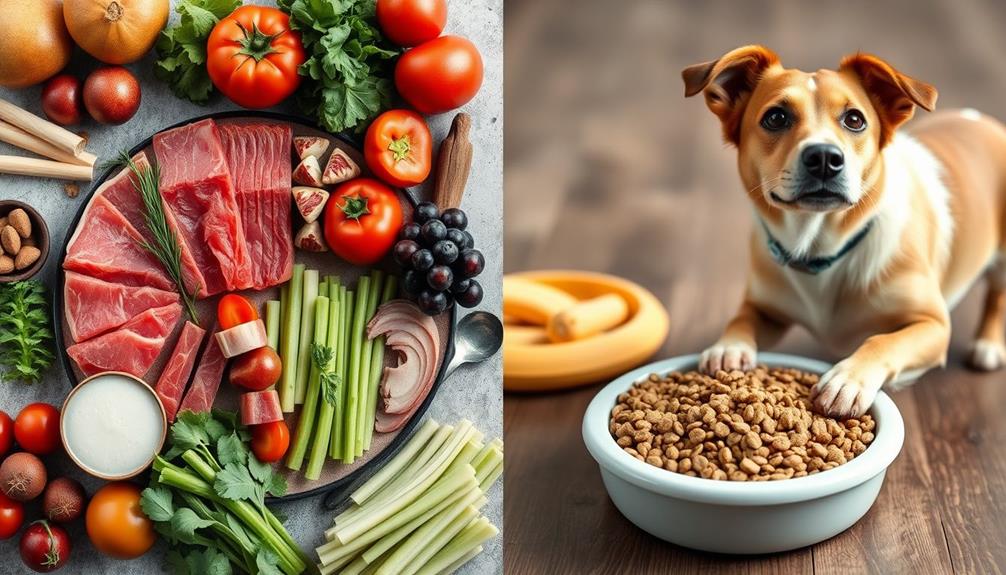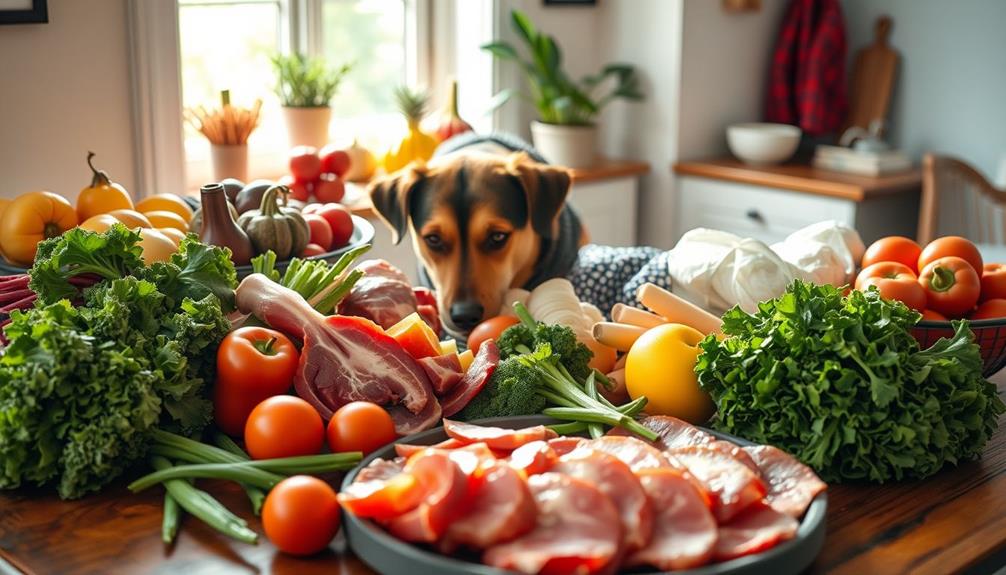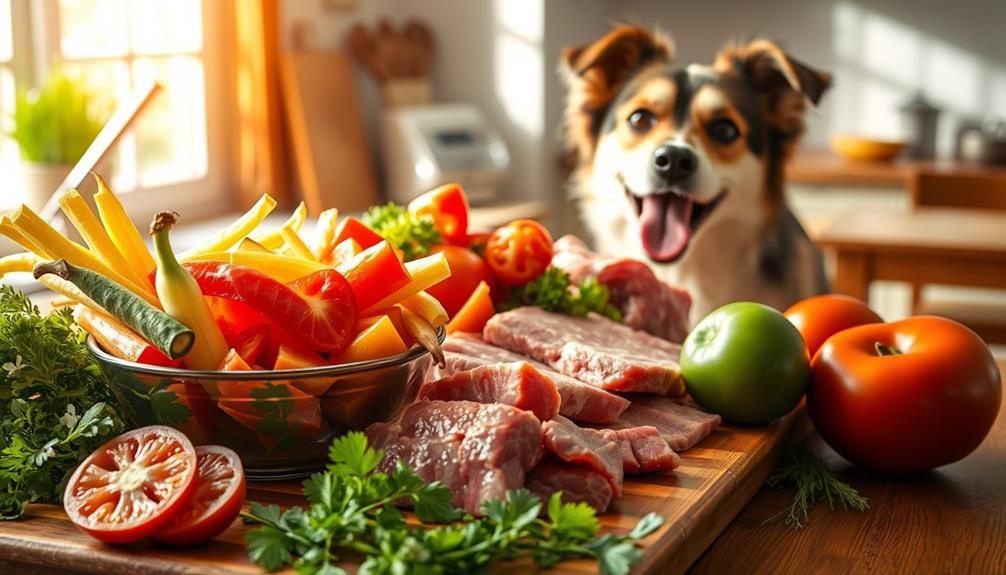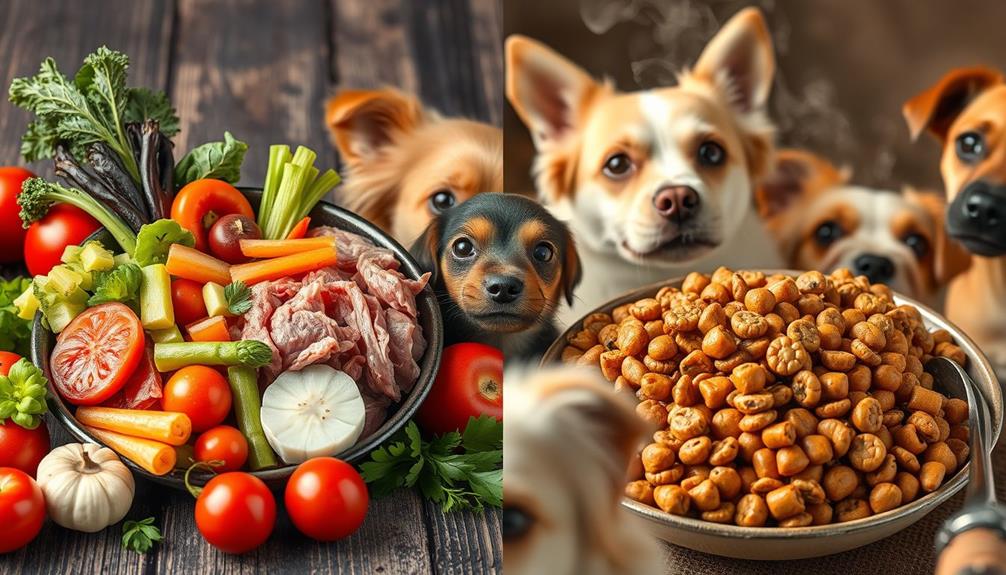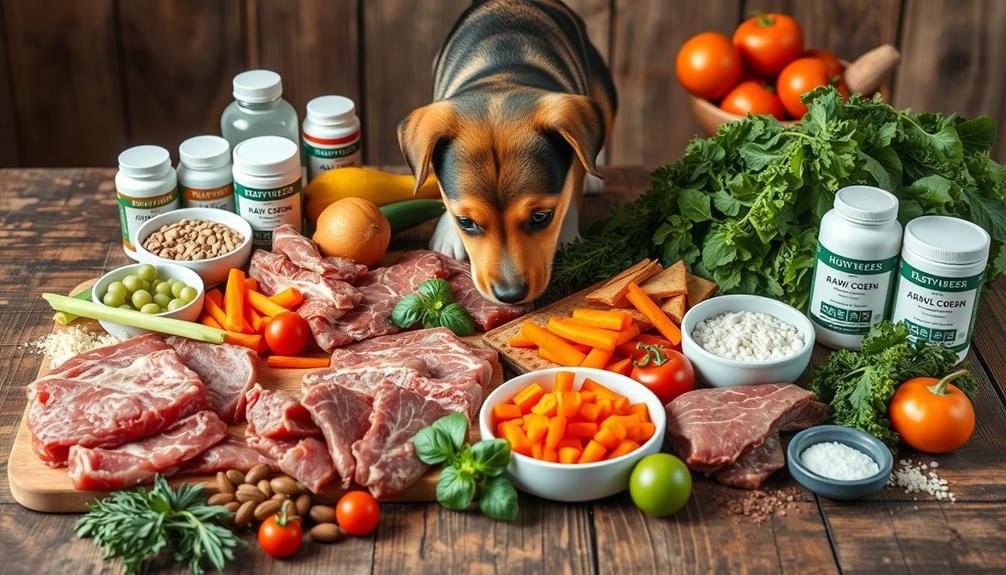To determine how much raw food to feed your dog, start by weighing them and calculating 2-3% of their ideal body weight. Active or underweight dogs might need up to 3%, while senior or overweight dogs should get around 1.5%. Smaller breeds often require 4-6%, whereas larger breeds need less. It's essential to adjust portions based on your dog's activity level and monitor their body condition regularly. Always divide daily portions into 1-2 meals for better digestion. Keep following for more insights on maintaining a balanced and healthy raw food diet for your furry friend.
Key Takeaways
- Feed adult dogs 2-3% of their ideal body weight daily; adjust based on activity level and health status.
- Active or underweight dogs may require up to 3% of their body weight for proper nutrition.
- Senior or overweight dogs should be fed approximately 1.5% of their ideal body weight to manage weight effectively.
- Smaller breeds typically need a higher percentage (4-6%), while larger breeds require less food relative to their weight.
- Divide daily portions into 1-2 meals to aid digestion and maintain energy levels throughout the day.
Factors Influencing Dog Diet
When it comes to your dog's diet, several factors play an essential role in determining their nutritional needs. Your dog's weight and activity level are key considerations. An active dog typically requires more calories than a sedentary one, so you'll need to adjust the portions accordingly.
If you're feeding your dog a raw food diet, it's imperative to guarantee it remains balanced to meet their specific requirements. Incorporating healthy dog snacks such as natural ingredients can enhance their overall diet, promoting wellness and satisfaction.
Additionally, monitoring your dog's body weight is significant for maintaining their health. If you notice your dog is underweight, you may need to increase their food intake. Conversely, if your dog is an overweight adult, reducing their portions can help them shed those extra pounds.
Outdoor temperatures can also influence your dog's caloric needs; colder weather may require you to feed your dog a bit more.
Consulting with an integrative veterinarian can provide you with personalized dietary advice tailored to your dog's unique situation. This will help you create a feeding plan that supports a balanced diet, guaranteeing your furry friend thrives while enjoying their raw food diet.
Feeding Guidelines for Puppies

Establishing a solid feeding routine is fundamental for a puppy's growth and development. You should feed your puppy 2-3 times daily, with portion sizes ranging from 10% of their current weight or 2-3% of their ideal adult weight.
For very young puppies aged 5-8 weeks, more frequent feedings are essential to support their rapid growth and development. As they mature, shifting to twice-daily feedings is typically recommended for peak nutrition.
It's important to provide a balanced diet that includes fresh fruits and vegetables, similar to the recommendations for other pets like hamsters, to guarantee they receive adequate nutrients proper diet for pets.
It's critical to monitor your puppy's weight regularly and adjust food amounts accordingly to guarantee healthy growth. Pay close attention to their body condition and activity level, as these factors can influence their dietary needs.
If you're following a raw diet, consider incorporating nutritional supplements like fish oil and probiotics to enhance their overall health and well-being.
Raw Food Portions for Adults

Feeding your adult dog a raw food diet requires careful attention to portion sizes to confirm they remain healthy and vibrant. The general guideline is to feed your adult dog 2-3% of their ideal body weight per day. If you have an active or underweight dog, you might need to increase the amount of food to around 3% of their body weight daily. Conversely, for senior or overweight dogs, aim for about 1.5% to assist in weight management. When it comes to feeding raw food for dogs, it’s important to take into account any specific dietary needs or health conditions your dog may have. Additionally, monitoring your dog’s body condition and adjusting portion sizes accordingly is crucial for maintaining their overall health. It’s always best to consult with a veterinarian or a canine nutrition specialist to ensure that you are providing a balanced and appropriate raw food diet for your adult dog.
It's crucial to acknowledge that a balanced diet can help prevent health issues, similar to how cold medications can provide effective relief when used appropriately.
It's essential to remember that smaller breeds typically need a higher percentage of their weight per day, about 4-6%, while larger breeds usually require less. To maintain a balanced diet, consider dividing the daily portion into 1-2 meals per day, with many owners opting for two meals. This allows your adult dog to digest their RAW FOOD more effectively and maintain energy levels throughout the day.
When determining how much to feed my adult dog, always adjust based on their activity level and overall health. Monitoring their response to the diet will help you fine-tune the amounts and keep them happy and healthy.
Assessing Ideal Weight

Evaluating your dog's ideal weight is vital for maintaining their health and well-being. Start by observing their body condition. A healthy dog should have a visible waist and ribs that feel like the back of your hand.
It's essential to recognize that proper weight management can help prevent potential health issues in older dogs, making it critical to reflect on financial considerations for elderly care when planning for their needs. Keep in mind that ideal weight can vary by breed, so it's essential to take into account breed-specific standards when evaluating your dog's condition.
If your dog's ribs feel similar to the area between the palm and thumb, they may be overweight and need adjustments in feeding. Conversely, if their ribs feel like knuckles, they could be underweight, indicating a need for increased food intake.
Regularly check your dog's current weight and body condition to guarantee they remain within a healthy range. Consulting with your veterinarian can provide valuable insights into your adult dog's ideal weight and overall health.
They can offer a baseline recommendation tailored to your dog's specific needs, especially when changing to a raw food diet. By staying proactive about your dog's weight, you can help them achieve a healthier, happier life.
Benefits of Raw Feeding

Making informed choices about your dog's diet can greatly impact their overall health and well-being. One popular option is raw feeding, which offers several benefits for your furry friend. Here are some key advantages:
1. Improved Digestion: Raw diets promote better digestion and nutrient absorption, supporting your dog's overall health.
Additionally, the natural enzymes in raw food can aid in breaking down nutrients more effectively, leading to enhanced digestive health.
2. Healthier Skin and Coat: Many dogs on a raw diet experience healthier skin and a shinier coat, thanks to the high-quality nutrients found in raw food.
This is similar to the benefits seen in other natural diets, such as those rich in antioxidants, which can also support skin health promoting hydration.
3. Enhanced Immune System: A raw diet can boost your dog's immune system and help reduce allergy symptoms, contributing to better long-term health.
4. Weight Control and Dental Health: Consistent raw feeding aids in weight control, reducing the risk of obesity-related health problems.
Plus, it leads to cleaner teeth and fresher breath, which can decrease dental issues.
Frequently Asked Questions
How Much Raw Food Should I Feed My Dog Chart?
To determine how much raw food to feed your dog, refer to a feeding chart that considers their weight and activity level. Adjust portions accordingly, ensuring your dog maintains a healthy body condition.
What Weight of Raw Food Should I Give My Dog?
Did you know smaller dogs often need 5-6% of their body weight in raw food? To determine how much to feed your dog, consider their weight, activity level, and adjust based on their health needs.
How to Calculate Raw Diet for Dogs?
To calculate a raw diet for your dog, start by determining their ideal body weight. Then, feed them 2-5% of that weight daily, adjusting based on activity level and monitoring their body condition regularly.
How Much Should I Feed My Dog Calculator by Weight?
Imagine your dog, a happy pup, thriving on the right diet. To determine how much to feed, use a calculator that considers their weight, aiming for 2-3% of their ideal body weight daily.
Conclusion
To summarize, feeding your dog a raw food diet can lead to healthier, happier pets. Did you know that dogs on a raw diet can have a 30% lower risk of obesity? By understanding the factors influencing your dog's dietary needs and evaluating their ideal weight, you can determine the right portion sizes. Remember, each dog is unique, so adjust their diet accordingly. Embrace the benefits of raw feeding for a vibrant, energetic companion!


